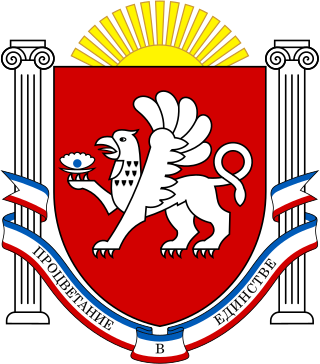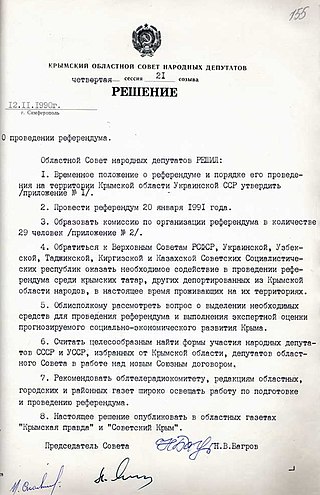
During the existence of the Soviet Union, different governments existed within the Crimean Peninsula. From 1921 to 1936, the government in the Crimea was known as the Crimean Autonomous Socialist Soviet Republic and was an Autonomous Soviet Socialist Republic within the Russian Soviet Federative Socialist Republic (SFSR); from 1936 to 1945, the name was slightly altered to the Crimean Autonomous Soviet Socialist Republic.

In 1954, the Presidium of the Supreme Soviet transferred the Crimean Oblast to the Ukrainian SSR from the Russian SFSR. The territory had been recognized within the Soviet Union as having "close ties" to the Ukrainian SSR, and the transfer itself commemorated the Union of Russia and Ukraine Tercentenary. Amidst the dissolution of the Soviet Union in 1991, the Ukrainian SSR seceded from the Soviet Union and Ukraine continued to exercise sovereignty over the territory as the Autonomous Republic of Crimea. For just over two decades after 1991, Russia did not dispute the Ukrainian administration in Crimea, but retracted this stance on 18 March 2014, when Crimea was annexed by Russia after coming under Russian military occupation. The Soviet-era transfer of Crimea has remained a topic of contention between the two countries in light of the Russo-Ukrainian War, as the Russian government has stated that the Ukrainians must recognize Russia's sovereignty over the territory as part of any negotiated settlement to end the Russian invasion of Ukraine, which began in 2022.

A referendum on the Act of Declaration of Independence was held in Ukraine on 1 December 1991. An overwhelming majority of 93% of voters approved the declaration of independence made by the Verkhovna Rada on 24 August 1991. Voters were asked "Do you support the Act of Declaration of Independence of Ukraine?" The text of the Declaration was included as a preamble to the question. The referendum was called by the Parliament of Ukraine to confirm the Act of Independence, which was adopted by the Parliament on 24 August 1991. Citizens of Ukraine expressed overwhelming support for independence. In the referendum, 31,891,742 registered voters took part, and among them 28,804,071 voted "Yes".
The politics of Crimea today is that of the Republic of Crimea on one hand, and that of the federal city of Sevastopol on the other, within the context of the largely unrecognised annexation of Crimea by the Russian Federation in March 2014.

The President of the Republic of Crimea was the head of the then-styled Republic of Crimea, Ukraine from February 16, 1994, to the time of the liquidation of this position on March 17, 1995. The post was liquidated as it contradicted the Constitution of Ukraine.
Yuri Aleksandrovich Meshkov was a Ukrainian politician and leader of the pro-Russian movement in Crimea. He served as the only President of Crimea from 1994 to 1995.
The only presidential elections were contested in the Republic of Crimea for the post of President of Crimea, at the time a republic within Ukraine. The office was created by the Verkhovna Rada of Crimea, the republic's unicameral parliament October 13, 1993. Elections were subsequently held on January 16, 1994 with the second round on January 30 since a two-round system was used to elect the President. The presidential elections in Crimea were one of the most important precedents of the Crimean crisis that laid the basis for the Ukrainian-Russian international relationship.

The Constitution of the Autonomous Republic of Crimea is the basic law of the Autonomous Republic of Crimea, a republic on the Crimean peninsula as part of Ukraine. The constitution establishes the republic's status and authority within Ukraine. It granted Crimea the right to draft a budget and manage its own property.
The Crimean status referendum of 2014 was a disputed referendum on March 16, 2014, concerning the status of Crimea that was conducted in the Autonomous Republic of Crimea and the city of Sevastopol after Russian forces seized control of Crimea.

A referendum on autonomy was held in the Crimean Oblast of the Ukrainian SSR on 20 January 1991, two months before the 1991 All-Union referendum. Voters were asked whether they wanted to re-establish the Crimean Autonomous Soviet Socialist Republic, which had been abolished in 1945. The proposal was approved by 94% of voters.
A three-part referendum was held in Crimea on 27 March 1994 alongside regional and national elections. Voters were asked whether they were in favour of greater autonomy within Ukraine, whether residents should have dual Russian and Ukrainian citizenship, and whether presidential decrees should have the status of laws. All three proposals were approved.

The Autonomous Republic of Crimea is an administrative division of Ukraine encompassing most of Crimea that was annexed by Russia in 2014. The Autonomous Republic of Crimea occupies most of the peninsula, while the City of Sevastopol occupies the rest.

In February and March 2014, Russia invaded the Crimean Peninsula, part of Ukraine, and then annexed it. This took place in the relative power vacuum immediately following the Revolution of Dignity. It marked the beginning of the Russo-Ukrainian War.

The Republic of Crimea is a republic of Russia, comprising most of the Crimean Peninsula, but excluding Sevastopol. Its territory corresponds to the pre-2023 territory of Autonomous Republic of Crimea, a subdivision of Ukraine. Russia occupied and annexed the peninsula in 2014, although the annexation remains internationally unrecognized.
The Crimean problem or the Crimean question is a dispute over the status of Crimea between Ukraine and Russia. The dispute began during the dissolution of the Soviet Union, but did not escalate into a conflict until the 2014 Ukrainian revolution, when Russian special forces were deployed to occupy Crimea and took over its government buildings. The official results of an internationally unrecognized referendum held during the occupation allegedly indicated overwhelming support for Russian annexation. The Crimean parliament and the autonomous city of Sevastopol unilaterally declared independence from Ukraine to ideally form a country named Republic of Crimea. Russia then annexed the region and created two federal subjects, the Republic of Crimea and Sevastopol. Ukraine and the majority of the international community continue to regard Crimea as occupied Ukrainian territory; a United Nations General Assembly resolution declared the referendum invalid and affirmed the territorial integrity of Ukraine. Despite international opinion however, the currency, tax, time zone and legal system are all operational under de facto Russian control. Ukraine has attempted to resolve the matter by filing litigation in multiple international criminal, environmental, political, and other courts.

The Head of the Republic of Crimea is the highest official and the head of the executive power of the Republic of Crimea; an internationally disputed federal subject of the Russian Federation located on the Crimean Peninsula.
A variety of social, economical, cultural, ethnic, and linguistic factors contributed to the sparking of unrest in eastern and southern Ukraine in 2014, and the subsequent eruption of the Russo-Ukrainian War, in the aftermath of the early 2014 Revolution of Dignity.

The Crimean Autonomous Soviet Socialist Republic was a polity on the Crimean Peninsula within the Ukrainian Soviet Socialist Republic that was formed during the collapse of the Soviet Union and a year later was renamed the Republic of Crimea.

With the dissolution of the Soviet Union and Ukrainian independence the majority ethnic Russian Crimean peninsula was reorganized as the Republic of Crimea, after a 1991 referendum with the Crimean authorities pushing for more independence from Ukraine and closer links with Russia. In 1995 the Republic was forcibly abolished by Ukraine with the Autonomous Republic of Crimea established firmly under Ukrainian authority. There were also intermittent tensions with Russia over the Soviet Fleet, although a 1997 treaty partitioned the Soviet Black Sea Fleet allowing Russia to continue basing its fleet in Sevastopol with the lease extended in 2010. Following the impeachment of the relatively pro-Russia Ukrainian President Viktor Yanukovych, Russia invaded Crimea, overthrew the elected Autonomous government and claimed to annex it in 2014.
After a referendum on 20 January 1991, Crimea regained its status as an Autonomous Soviet Socialist Republic. As this was months before the Declaration of Independence of Ukraine on 24 August 1991 — by December 1991 internationally recognized — Crimea was at the time part of the Ukrainian SSR which was one of the constituent republics of the Soviet Union.














